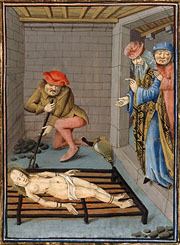 | ||
The Cançó (or Cançon) de Santa Fe ([kanˈsu ðe ˈsantɔ ˈfe], [kənˈso ðə ˈsantə ˈfe]; French: Chanson de Sainte Foi d'Agen, English: Song of Saint Fides), a hagiographical poem about Saint Faith, is the earliest surviving written work in a Catalan dialect of Old Occitan. It is 593 octosyllabic lines long, divided into between 45 and 55 monorhyming laisses. It was written between 1054 and 1076, during the reign of Ramon Berenguer I, Count of Barcelona, by an anonymous poet.
The place of its composition is controversial. It may have been written in the region around Narbonne. On the other hand, it may belong to the Roussillon, either to the monstery of Sant Miquel de Cuixà, where relics pertaining to Saint Faith are to be found, or that of Sant Martí del Canigó. In Roussillon in the eleventh century, the name Faith (Fides) was relatively common. Other suggested regions include Provence, Cerdagne, and Quercy.
The language or dialect of the poem is also debated, since on it hinge the nationalist pride of Catalonia and the thesis that Catalan and Occitan, the language of southern France, were indistinct before the fourteenth century. Ernst Hoepffner (1926) argued that it was "certainly not Catalan". Martín de Riquer (1964) agrees that "one cannot affirm the Catalanity of this beautiful and ingenious poem indubitably". Aurelio Roncaglia (1961) suggests it was written in the lingua d'oc (Occitan) but ai margini della Catalogna (on the margins of Catalonia). As early as 1581 Claude Fauchet believed it was vieil espagnol, pour le moins cathalan (old Spanish, at least Catalan), but the manuscript Fauchet worked from disappeared. It was rediscovered in 1901 among the works of Ausiàs March in the library of the University of Leiden by José Leite de Vasconcelos. It had evidently been misplaced in 1716 based on its misidentification as a work of March's in 1562. In 1962 J. W. B. Zaal studied Fauchet's manuscript and on the basis of the words razo espanesca found in the Cançó, determined that it was culturally transpyrenean. The manuscript history further supports the notion that the language of the Cançó is of a more Iberian dialect (so that it could be mistaken for late medieval Catalan).
The Cançó is a versified narration of the martyrdom of Saint Faith in Agen (c. 300). It is primarily based on the now lost Latin Passio sanctorum Fidis et Caprisii, though seven Latin sources have been identified, including the De mortibus persecutorum of Lactantius.
Elisabeth Work divides it into two distinct parts: a conventional chanson de saint that lasts the first 41 laisses and is based on the traditional sources, and an original chanson de felon corresponding to the final eight laisses. The first part is eloquent and polished, while the latter part is mediocre, often attributed to the phrase a lei francesca, which is taken to indicate that the poet was composing in the manner of the Old French narrative lay. The poet himself narrates the final part with an air of disgust appropriate to the felonious content. Everywhere, however, his language is orthographically, lexically, and rhythmically consistent.
According to the final lines of its razo (prologue), the Cançó was popular in the regions of Vasconia, Aragon, and Gascony, where the people can affirm its truth:
Tota Basconn'et Aragonse l'encontrada delz gasconssabon qals es aqist canczons,o ss'es ben vera·sta razons...